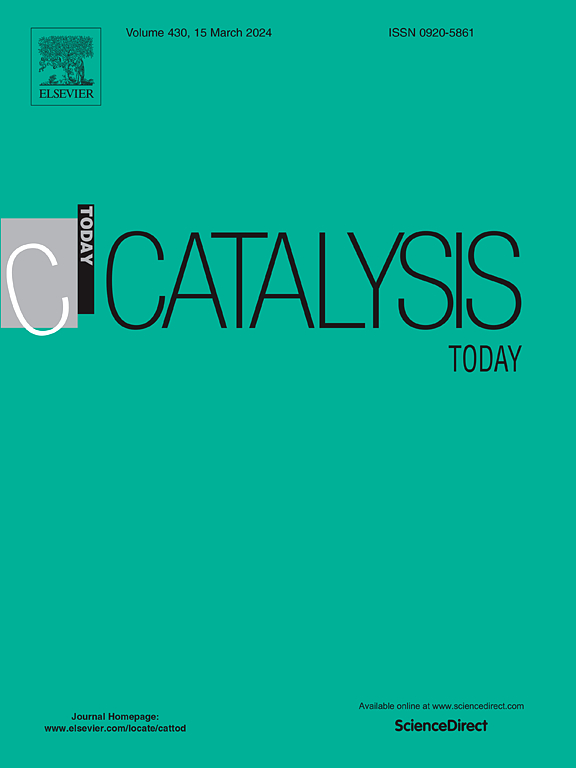Ru-Co/SiC催化剂上氨高效制氢
IF 5.3
2区 化学
Q1 CHEMISTRY, APPLIED
引用次数: 0
摘要
本研究对钌和钴有序浸渍对β-SiC载体作为高效绿色氨制氢催化剂的影响提供了有价值的见解。采用程序升温还原、x射线衍射、透射电镜和扫描电镜等技术对催化剂进行了表征。Ru的加入明显改变了还原曲线,降低了获得金属形态的温度。共浸渍法制备的催化剂抑制了Co硅酸盐的生成,使其难以还原。此外,浸渍顺序对金属晶粒尺寸也有影响,共浸渍法的晶粒尺寸最小,产氢量最高。另一方面,在350℃时,与总金属含量为5 wt%的催化剂相比,总金属含量为2.5 wt%的催化剂的产氢率提高了41 %,证明了使用较低的金属负荷是合理的。因此,以50/50 wt比和2.5 wt%的金属负载Ru/Co共浸渍获得了最高的活性,在50 小时的反应中表现出优异的活性和稳定性,转化率为95 %。本文章由计算机程序翻译,如有差异,请以英文原文为准。
Efficient hydrogen production from ammonia over Ru-Co/SiC catalysts
This study provides a valuable insight into the influence of the order impregnation of ruthenium and cobalt on β-SiC support as catalysts for efficient green hydrogen production from ammonia. The catalysts were characterized using different techniques such as Temperature Programmed Reduction, X-Ray Diffraction, Transmission Electron Microscopy and Scanning Electron Microscopy. The addition of Ru clearly changed the reduction profile, decreasing the temperature to obtain metallic species. The catalyst prepared by co-impregnation inhibited the formation of Co silicates, which are very difficult to reduce. Additionally, the metal size was also affected by the order of impregnation, with the co-impregnation method showing the smallest crystallite sizes and the highest hydrogen production. On the other hand, it was found that the 2.5 wt% total metal content catalyst improved the hydrogen production rate by 41 % compared to 5 wt% total metal content at 350 ºC, justifying the use of a lower metal loading. Therefore, the highest activity was achieved with a Ru/Co co-impregnation with a 50/50 wt ratio and a metal loading of 2.5 wt%, which exhibited excellent activity and stability with 95 % conversion over 50 hours of reaction.
求助全文
通过发布文献求助,成功后即可免费获取论文全文。
去求助
来源期刊

Catalysis Today
化学-工程:化工
CiteScore
11.50
自引率
3.80%
发文量
573
审稿时长
2.9 months
期刊介绍:
Catalysis Today focuses on the rapid publication of original invited papers devoted to currently important topics in catalysis and related subjects. The journal only publishes special issues (Proposing a Catalysis Today Special Issue), each of which is supervised by Guest Editors who recruit individual papers and oversee the peer review process. Catalysis Today offers researchers in the field of catalysis in-depth overviews of topical issues.
Both fundamental and applied aspects of catalysis are covered. Subjects such as catalysis of immobilized organometallic and biocatalytic systems are welcome. Subjects related to catalysis such as experimental techniques, adsorption, process technology, synthesis, in situ characterization, computational, theoretical modeling, imaging and others are included if there is a clear relationship to catalysis.
 求助内容:
求助内容: 应助结果提醒方式:
应助结果提醒方式:


